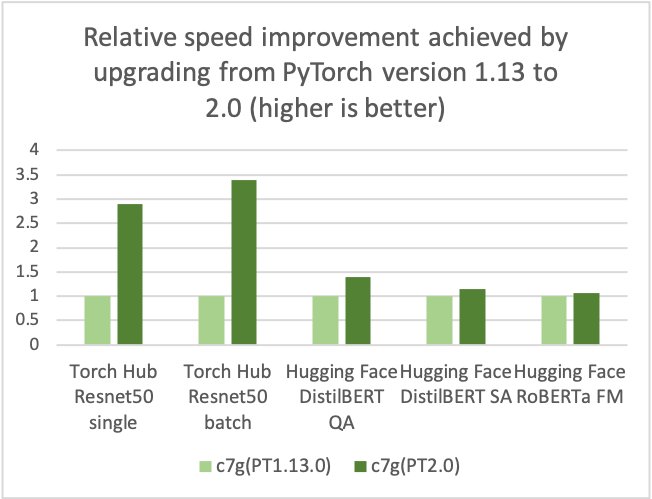
Optimized PyTorch 2.0 inference with AWS Graviton processors

New generations of CPUs offer a significant performance improvement in machine learning (ML) inference due to specialized built-in instructions…0 inference for Arm-based processors… As a result, we are delighted to announce that AWS Graviton-based instance inference performance for PyTorch 2… …
New generations of CPUs offer a significant performance improvement in machine learning (ML) inference due to specialized built-in instructions. Combined with their flexibility, high speed of development, and low operating cost, these general-purpose processors offer an alternative to other existing hardware solutions.
AWS, Arm, Meta and others helped optimize the performance of PyTorch 2.0 inference for Arm-based processors. As a result, we are delighted to announce that AWS Graviton-based instance inference performance for PyTorch 2.0 is up to 3.5 times the speed for Resnet50 compared to the previous PyTorch release (see the following graph), and up to 1.4 times the speed for BERT, making Graviton-based instances the fastest compute optimized instances on AWS for these models.

AWS measured up to 50% cost savings for PyTorch inference with AWS Graviton3-based Amazon Elastic Cloud Compute C7g instances across Torch Hub Resnet50, and multiple Hugging Face models relative to comparable EC2 instances, as shown in the following figure.

Additionally, the latency of inference is also reduced, as shown in the following figure.

We have seen a similar trend in the price-performance advantage for other workloads on Graviton, for example video encoding with FFmpeg.
Optimization details
The optimizations focused on three key areas:
- GEMM kernels – PyTorch supports Arm Compute Library (ACL) GEMM kernels via the OneDNN backend (previously called MKL-DNN) for Arm-based processors. The ACL library provides Neon and SVE optimized GEMM kernels for both fp32 and bfloat16 formats. These kernels improve the SIMD hardware utilization and reduce the end-to-end inference latencies.
- bfloat16 support – The bfloat16 support in Graviton3 allows for efficient deployment of models trained using bfloat16, fp32, and AMP (Automatic Mixed Precision). The standard fp32 models use bfloat16 kernels via OneDNN fast math mode, without model quantization, providing up to two times faster performance compared to the existing fp32 model inference without bfloat16 fast math support.
- Primitive caching – We also implemented primitive caching for conv, matmul, and inner product operators to avoid redundant GEMM kernel initialization and tensor allocation overhead.
How to take advantage of the optimizations
The simplest way to get started is by using the AWS Deep Learning Containers (DLCs) on Amazon Elastic Compute Cloud (Amazon EC2) C7g instances or Amazon SageMaker. DLCs are available on Amazon Elastic Container Registry (Amazon ECR) for AWS Graviton or x86. For more details on SageMaker, refer to Run machine learning inference workloads on AWS Graviton-based instances with Amazon SageMaker and Amazon SageMaker adds eight new Graviton-based instances for model deployment.
Use AWS DLCs
To use AWS DLCs, use the following code:
If you prefer to install PyTorch via pip, install the PyTorch 2.0 wheel from the official repo. In this case, you will have to set two environment variables as explained in the code below before launching PyTorch to activate the Graviton optimization.
Use the Python wheel
To use the Python wheel, refer to the following code:
Run inference
You can use PyTorch TorchBench to measure the CPU inference performance improvements, or to compare different instance types:
Benchmarking
You can use the Amazon SageMaker Inference Recommender utility to automate performance benchmarking across different instances. With Inference Recommender, you can find the real-time inference endpoint that delivers the best performance at the lowest cost for a given ML model. We collected the preceding data using the Inference Recommender notebooks by deploying the models on production endpoints. For more details on Inference Recommender, refer to the GitHub repo. We benchmarked the following models for this post: ResNet50 image classification, DistilBERT sentiment analysis, RoBERTa fill mask, and RoBERTa sentiment analysis.
Conclusion
AWS measured up to 50% cost savings for PyTorch inference with AWS Graviton3-based Amazon Elastic Cloud Compute C7g instances across Torch Hub Resnet50, and multiple Hugging Face models relative to comparable EC2 instances. These instances are available on SageMaker and Amazon EC2. The AWS Graviton Technical Guide provides the list of optimized libraries and best practices that will help you achieve cost benefits with Graviton instances across different workloads.
If you find use cases where similar performance gains aren’t observed on AWS Graviton, please open an issue on the AWS Graviton Technical Guide to let us know about it. We will continue to add more performance improvements to make Graviton the most cost-effective and efficient general-purpose processor for inference using PyTorch.
About the author
 Sunita Nadampalli is a Software Development Manager at AWS. She leads Graviton software performance optimizations for machine leaning, HPC, and multimedia workloads. She is passionate about open-source development and delivering cost-effective software solutions with Arm SoCs.
Sunita Nadampalli is a Software Development Manager at AWS. She leads Graviton software performance optimizations for machine leaning, HPC, and multimedia workloads. She is passionate about open-source development and delivering cost-effective software solutions with Arm SoCs.
Author: Sunita Nadampalli
